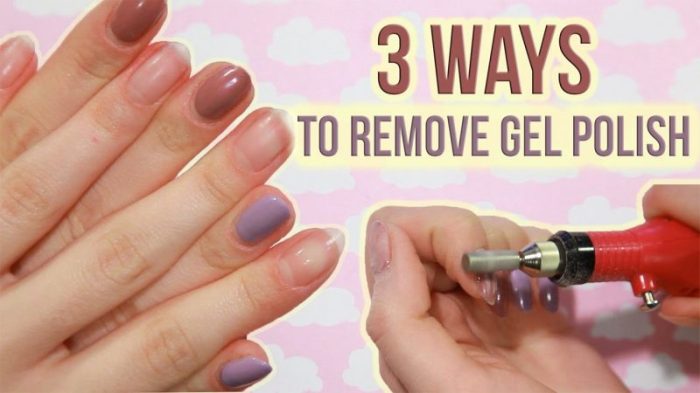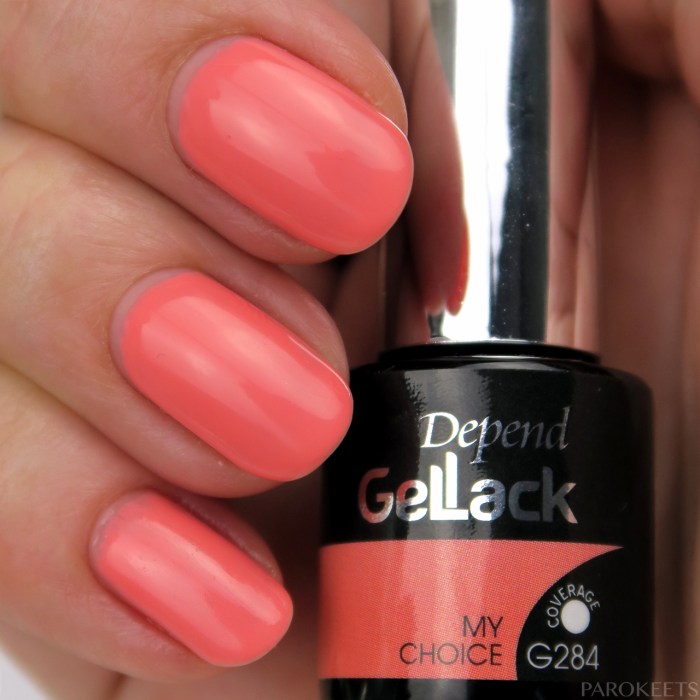What to Use to Remove Gel Nail Polish
Safe Gel Polish Removal at Home
What to use to remove gel nail polish – Removing gel polish at home can be achieved safely and effectively with the right techniques and materials. Improper removal can damage your natural nails, leading to brittleness, peeling, and even infection. This section details safe methods, highlighting crucial safety precautions to protect your nails and skin.
Acetone-Based Gel Polish Removal
Acetone is the most effective solvent for dissolving gel polish. However, it’s crucial to follow a step-by-step process and take necessary safety precautions to minimize potential harm.
- Gather your materials: acetone, cotton balls or pads, foil, cuticle pusher or orangewood stick, nail buffer, cuticle oil, and hand cream.
- Prepare your workspace: Choose a well-ventilated area to avoid inhaling excessive acetone fumes. Consider wearing gloves to protect your skin.
- Saturate cotton pads with acetone and place them on your nails, covering each nail completely.
- Wrap each fingertip tightly with aluminum foil to keep the acetone-soaked cotton pads in place and prevent evaporation.
- Allow the acetone to soak for 10-15 minutes, or until the gel polish softens. The gel will typically start to lift from the nail plate.
- Gently remove the foil and cotton pads. Use a cuticle pusher or orangewood stick to carefully scrape off the softened gel polish. Avoid excessive force to prevent damaging your natural nails.
- Once all the gel is removed, gently buff your nails to smooth any remaining residue. Apply cuticle oil and hand cream to moisturize and nourish your nails and cuticles.
E-File Gel Polish Removal

Source: cosmeticnews.com
Professional e-files can efficiently remove gel polish, but improper use can severely damage the nail plate. This method should only be performed by trained professionals with proper safety equipment and experience.
Risks associated with e-file use include over-filing, leading to thinning and weakening of the nails, and potential for skin injury if not handled correctly. Safety measures include using a low-speed setting, keeping the bit moving to avoid overheating the nail, and maintaining a light touch.
Acetone vs. Non-Acetone Removers
Acetone-based removers are significantly more effective at dissolving gel polish than non-acetone removers. Non-acetone removers are gentler but often require longer soaking times and may not completely remove stubborn gel polish. Choose based on your nail’s sensitivity and the stubbornness of your gel polish.
Minimizing Nail Damage During Removal, What to use to remove gel nail polish
To minimize damage, avoid aggressive scraping or filing. Ensure adequate soaking time to soften the gel before attempting removal. Use a low grit buffer to smooth the nail surface after removal, and always moisturize your nails and cuticles afterward.
| Product Name | Ingredients | Price (approx.) | Availability |
|---|---|---|---|
| Example Acetone Remover A | Acetone, water, fragrance | $5 | Drugstores |
| Example Acetone Remover B | Acetone, emollients, vitamin E | $8 | Beauty Supply Stores |
| Example Acetone Remover C | Pure Acetone | $10 | Online Retailers |
Tools and Materials Needed for Gel Polish Removal
Having the right tools and materials is crucial for a safe and effective gel polish removal process at home. This checklist ensures you have everything you need before you begin.
Essential Materials Checklist
Organizing your materials into categories helps streamline the process. High-quality acetone and cotton pads are essential for optimal results.
- Solvents: Acetone (high-quality is recommended for faster and more efficient removal), non-acetone remover (optional, for sensitive nails).
- Tools: Cuticle pusher or orangewood stick, nail buffer (low-grit), aluminum foil.
- Protective Equipment: Gloves (to protect skin from acetone), well-ventilated area (to avoid inhaling fumes).
- Other: Cotton balls or pads (high-quality cotton pads are less likely to leave lint), cuticle oil, hand cream.
High-quality acetone evaporates more slowly, allowing for more effective gel polish dissolution. High-quality cotton pads are lint-free, preventing residue from sticking to the nails.
Dealing with Difficult Removal Situations
Stubborn gel polish can be challenging to remove, but several strategies can help soften and remove it without damaging your nails.
Softening Hardened Gel Polish
For stubborn gel, increase the soaking time with acetone, up to 20 minutes, or try gently warming the acetone-soaked cotton pads with a hairdryer (on a low setting) to accelerate the softening process. Avoid direct heat on the skin.
Common Mistakes and How to Avoid Them
Common mistakes include using excessive force during removal, insufficient soaking time, and using a low-quality acetone. Avoid these mistakes by following the steps Artikeld above and using high-quality materials.
Removing Gel Polish from Sensitive Skin
Apply a thin layer of petroleum jelly around the nail before applying the acetone to protect the skin. Use gentle pressure during removal and immediately wash your hands with mild soap and water after completing the process.
Handling Broken or Lifted Gel Polish
If the gel polish is already lifted or broken, gently push it off with a cuticle pusher or orangewood stick. Do not pull or force it, as this can damage the nail bed. If the gel is firmly attached, soak with acetone as usual.
Post-Removal Nail Care
Proper nail care after gel polish removal is essential to restore and strengthen your nails. This includes moisturizing and strengthening treatments to prevent damage and promote healthy nail growth.
Essential Post-Removal Nail Care Routines
- Apply cuticle oil daily to hydrate and protect the cuticles.
- Use a strengthening nail treatment to improve nail health and prevent breakage.
- Moisturize your hands regularly with a rich hand cream.
- Avoid harsh chemicals and prolonged water exposure.
- Give your nails a break from gel polish periodically to allow them to recover.
Recommended nail oils and treatments often contain vitamins and minerals that nourish and strengthen the nails. Examples include jojoba oil, argan oil, and cuticle serums enriched with biotin and keratin.
Professional Gel Polish Removal Options
Professional removal offers several advantages over at-home removal, including expertise, specialized tools, and a reduced risk of nail damage. However, it comes at a higher cost.
Professional Removal Process

Source: parokeets.com
Professional salons typically use e-files or a combination of soaking and filing to remove gel polish. They prioritize minimizing damage to the natural nail, using specialized techniques and equipment.
At-Home vs. Professional Removal
At-home removal is more cost-effective but requires careful attention to detail and technique to prevent nail damage. Professional removal is more expensive but offers convenience and expertise, reducing the risk of damage.
Choosing a Reputable Nail Salon
Look for salons with positive reviews, licensed technicians, and a clean, well-maintained environment. Inquire about their gel polish removal techniques and safety protocols.
Questions to Ask a Nail Technician
- What method do you use to remove gel polish?
- What precautions do you take to protect my natural nails?
- What products do you use?
- Do you have experience removing gel polish?
Visual Aids: Illustrating the Process: What To Use To Remove Gel Nail Polish
Visualizing the process enhances understanding. This section provides detailed descriptions of the visual aspects of gel polish removal.
Acetone Removal: A Visual Description
Initially, the gel polish appears smooth and glossy. After acetone application and soaking, the color may slightly fade, and the polish becomes noticeably softer and less glossy. As the gel is removed, it peels away in layers, revealing the natural nail underneath. If done correctly, the natural nail should appear smooth and undamaged.
Tools and Their Appearance
Acetone is a clear liquid. Cotton pads are soft and absorbent. Aluminum foil is a shiny, metallic material. Cuticle pushers are usually metal tools with a flat, slightly rounded edge. Nail buffers are typically rectangular blocks with different grit surfaces, often varying in color.
Healthy vs. Damaged Nails
Healthy nails are smooth, even, and have a consistent color. Damaged nails may appear thin, brittle, ridged, or discolored. They may also peel or break easily. Proper removal should leave the nails looking healthy and smooth, while improper removal can lead to significant damage and require more time to heal.
Essential Questionnaire
Can I use regular nail polish remover to remove gel polish?
No, regular nail polish remover is not strong enough to dissolve gel polish. You need acetone-based remover.
How often should I remove gel polish?
It’s recommended to remove gel polish every 2-3 weeks to prevent damage to your natural nails.
What if the gel polish is extremely stubborn?
Try gently filing the top layer of the gel to create more surface area for the acetone to penetrate. Soak for a longer period, and consider using a higher concentration of acetone.
My nails are very thin and brittle. What can I do?
Focus on intensive moisturizing and strengthening treatments after removal. Use cuticle oil regularly and consider nail strengtheners.
















